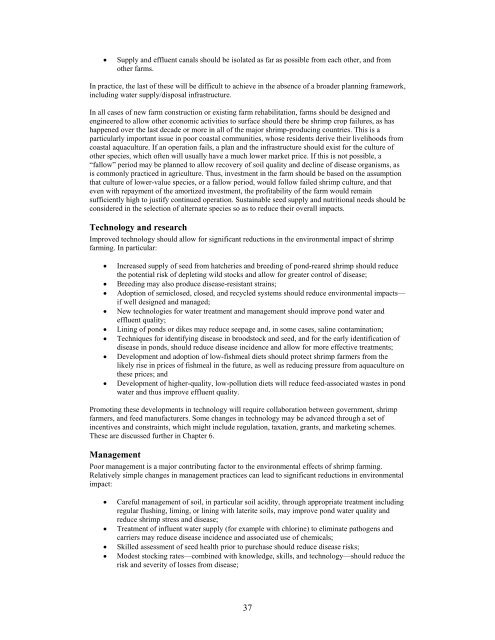Shrimp Farming and the Environment - Library
Shrimp Farming and the Environment - Library
Shrimp Farming and the Environment - Library
You also want an ePaper? Increase the reach of your titles
YUMPU automatically turns print PDFs into web optimized ePapers that Google loves.
• Supply <strong>and</strong> effluent canals should be isolated as far as possible from each o<strong>the</strong>r, <strong>and</strong> fromo<strong>the</strong>r farms.In practice, <strong>the</strong> last of <strong>the</strong>se will be difficult to achieve in <strong>the</strong> absence of a broader planning framework,including water supply/disposal infrastructure.In all cases of new farm construction or existing farm rehabilitation, farms should be designed <strong>and</strong>engineered to allow o<strong>the</strong>r economic activities to surface should <strong>the</strong>re be shrimp crop failures, as hashappened over <strong>the</strong> last decade or more in all of <strong>the</strong> major shrimp-producing countries. This is aparticularly important issue in poor coastal communities, whose residents derive <strong>the</strong>ir livelihoods fromcoastal aquaculture. If an operation fails, a plan <strong>and</strong> <strong>the</strong> infrastructure should exist for <strong>the</strong> culture ofo<strong>the</strong>r species, which often will usually have a much lower market price. If this is not possible, a“fallow” period may be planned to allow recovery of soil quality <strong>and</strong> decline of disease organisms, asis commonly practiced in agriculture. Thus, investment in <strong>the</strong> farm should be based on <strong>the</strong> assumptionthat culture of lower-value species, or a fallow period, would follow failed shrimp culture, <strong>and</strong> thateven with repayment of <strong>the</strong> amortized investment, <strong>the</strong> profitability of <strong>the</strong> farm would remainsufficiently high to justify continued operation. Sustainable seed supply <strong>and</strong> nutritional needs should beconsidered in <strong>the</strong> selection of alternate species so as to reduce <strong>the</strong>ir overall impacts.Technology <strong>and</strong> researchImproved technology should allow for significant reductions in <strong>the</strong> environmental impact of shrimpfarming. In particular:• Increased supply of seed from hatcheries <strong>and</strong> breeding of pond-reared shrimp should reduce<strong>the</strong> potential risk of depleting wild stocks <strong>and</strong> allow for greater control of disease;• Breeding may also produce disease-resistant strains;• Adoption of semiclosed, closed, <strong>and</strong> recycled systems should reduce environmental impacts—if well designed <strong>and</strong> managed;• New technologies for water treatment <strong>and</strong> management should improve pond water <strong>and</strong>effluent quality;• Lining of ponds or dikes may reduce seepage <strong>and</strong>, in some cases, saline contamination;• Techniques for identifying disease in broodstock <strong>and</strong> seed, <strong>and</strong> for <strong>the</strong> early identification ofdisease in ponds, should reduce disease incidence <strong>and</strong> allow for more effective treatments;• Development <strong>and</strong> adoption of low-fishmeal diets should protect shrimp farmers from <strong>the</strong>likely rise in prices of fishmeal in <strong>the</strong> future, as well as reducing pressure from aquaculture on<strong>the</strong>se prices; <strong>and</strong>• Development of higher-quality, low-pollution diets will reduce feed-associated wastes in pondwater <strong>and</strong> thus improve effluent quality.Promoting <strong>the</strong>se developments in technology will require collaboration between government, shrimpfarmers, <strong>and</strong> feed manufacturers. Some changes in technology may be advanced through a set ofincentives <strong>and</strong> constraints, which might include regulation, taxation, grants, <strong>and</strong> marketing schemes.These are discussed fur<strong>the</strong>r in Chapter 6.ManagementPoor management is a major contributing factor to <strong>the</strong> environmental effects of shrimp farming.Relatively simple changes in management practices can lead to significant reductions in environmentalimpact:• Careful management of soil, in particular soil acidity, through appropriate treatment includingregular flushing, liming, or lining with laterite soils, may improve pond water quality <strong>and</strong>reduce shrimp stress <strong>and</strong> disease;• Treatment of influent water supply (for example with chlorine) to eliminate pathogens <strong>and</strong>carriers may reduce disease incidence <strong>and</strong> associated use of chemicals;• Skilled assessment of seed health prior to purchase should reduce disease risks;• Modest stocking rates—combined with knowledge, skills, <strong>and</strong> technology—should reduce <strong>the</strong>risk <strong>and</strong> severity of losses from disease;37
















